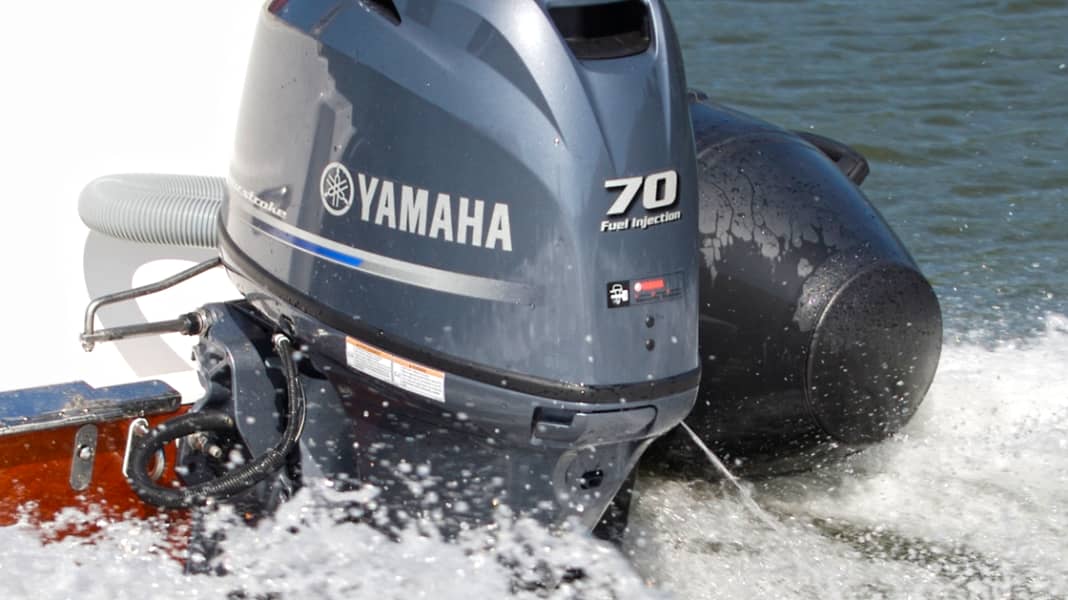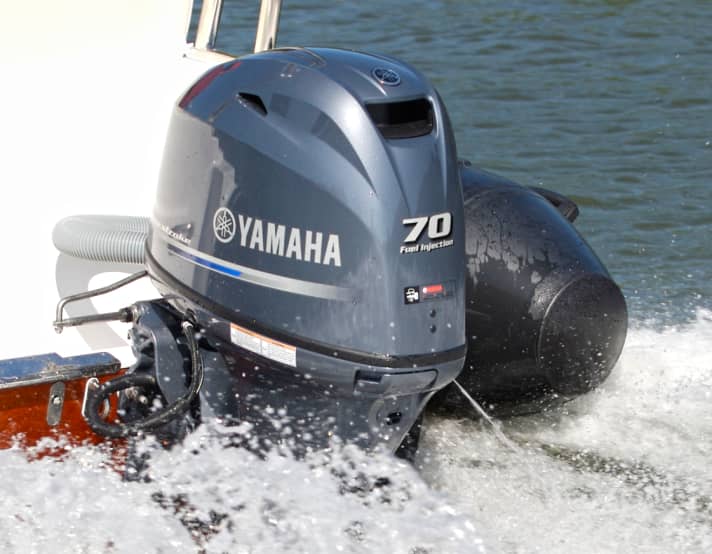

While car drivers are usually faced with the decision of petrol or diesel when choosing an engine for their vehicle, motorboat drivers looking for the right outboard motor for their "ship" are more likely to be faced with the question of "four-stroke or two-stroke?". a headache. In favour of the four-stroke engine are its smooth running and better fuel consumption values, while the two-stroke competition, which is still offered today as direct injection engines by Evinrude, Mercury and Tohatsu, is generally lighter and has excellent acceleration values.
The exception to the rule is the Yamaha F70. The 70 hp in-line four-cylinder weighs 119 kg and therefore has a power-to-weight ratio of 1.70 kg/hp. This means that one hp weighs 1.70 kg. The only direct competitor, Suzuki's DF70, weighs 2.21 kg for the same power. Even if the power class is topped up with the 75cc models, where the four-stroke from Honda (2.21 kg/hp) and the two-strokes from Evinrude (1.93 kg/hp) and Tohatsu (1.92 kg/hp) are available, the Yamaha remains the class leader in terms of power-to-weight ratio.
Among other things, the F70's 996 cc displacement and a gear ratio of 2.33:1, which allows large propellers with a high pitch to be fitted, ensure that it can also hold its own against the fast two-strokes when accelerating. And these are available off the shelf. When looking for the "right" prop, the F70 owner can choose from 23 different "screws" in the Yamaha range alone.
When looking for a suitable job, the F70 is preferably used on sports boats, cabin cruisers and inflatable boats in the 5 metre class. Provided their transom height is designed for long-shaft engines.
Behind the advertising slogan "the lightest engine in its class" is an in-line four-cylinder engine with a displacement of just under one litre, an overhead camshaft, four-valve technology and electronic fuel injection.
A microcomputer calculates and determines the optimum fuel quantity and the best injection and ignition timing, depending on the operating status and always well informed by numerous sensors. In conjunction with newly designed throttle valves and a precisely tuned intake manifold, Yamaha thus increases fuel efficiency. This means that fuel is saved and pollutant emissions are reduced. The computer also monitors important engine functions such as oil pressure, cooling and overspeed. If there are any problems, a visual and acoustic warning is given and the engine speed is automatically limited to a maximum of 2500 rpm.
With its electronic immobiliser, which is switched on and off at the touch of a button using a small remote control, and the quick stop switch with pull cord and an automatic start lock that prevents the engine from being started with forward or reverse gear engaged, the F70 scores further plus points in terms of safety.
Prime start, power trim and a smooth-running single-lever gearstick, which is available in various versions (top, side and flush-mounted), provide the desired ease of use. Thanks to the automatic cold start system (prime start), the F70's motto is "insert ignition key, turn and drive off".
The extended adjustment range (-4° to + 16°) of the power trim device allows the driver to bring the boat into the optimum floating position in (almost) any situation. At the touch of a button, of course. With the same hand movement, the idle speed can also be adjusted at any time in the range between 620 and 900 rpm.
An easy-to-read instrument cluster shows how high the engine is revving and what trim position it is currently in. If you want to know how fast you are travelling at that very moment and how much fuel the engine is consuming, you will need to invest in a second instrument that also provides information on the distance travelled, fuel tank capacity and temperatures.
Information on how to handle the engine in everyday use, when which maintenance work needs to be carried out and how to do "little things" yourself is provided in the clear and comprehensible operating instructions. One criticism that remains at this point is that a sufficiently large fuel filter with integrated water separator should not be included in the accessories catalogue, but in the standard equipment.
In the practical test, which it has to pass on a ZAR Fermenti 43, a 4.50 m long and 2.16 m wide RIB (you will find the boat test of the ZAR 43 in one of the next issues), the F70 shows itself from its best side. It starts immediately, whether cold or warm, and runs smoothly after just a few revolutions. Smoke signals: absent.
When the compact four-cylinder engine is stimulated to deliver maximum performance, it accelerates the boat, which weighs 700 kg with engine, full tank and test crew, from 0 to 50 km/h in 13.6 s and only a few moments later to a top speed of 64.1 km/h (34.6 kn). Not only the spontaneously responding power trim, but also the well-tuned aluminium propeller (part of the standard equipment) demonstrate real strength. In addition to the conversion of torque and power into thrust, the handling characteristics, economy and smooth running are also impressive.
The fact that the ZAR 43 can be easily steered into tight turns and circles without hooking and rocking is perhaps more due to the boat than the engine, that the prop does not gasp for air, but undoubtedly to the design of the propeller and underwater part and the chosen mounting height (anti-cavitation plate flush with the bottom of the boat) of the engine. If you want to go easy on the engine and your wallet, let the F70 turn at 4000 rpm and move the ZAR 43 equipped with a 100-litre built-in tank at a speed of 40 (km/h).
The 70 hp four-cylinder engine then consumes a meagre 0.26 l/km and allows the skipper to plan for a range of 327 km. If water skiing and top speed are on the wish list, consumption climbs to 0.34 l/km. The distance between refuelling stops is then 250 km.
That leaves the smooth running, which the F70 demonstrates most conspicuously through its lack of vibration and unobtrusive operating noise. Because, as we all know, the sound makes the music, the 90 dB/A measured at full load can be annoying in the long run. The only thing that helps is to ease off the throttle. Even at 57.5 km/h, the noise level remains below the critical 85 dB/A mark. If the speed limit is 40 km/h, the F70 at the ZAR 43 becomes a real quiet-runner at 78 dB/A.
Conclusion: Yamaha's F70 is not only characterised by its low weight and price. The modern four-stroke also impresses with its performance and economy, as well as its smooth running, safety and ease of use.

